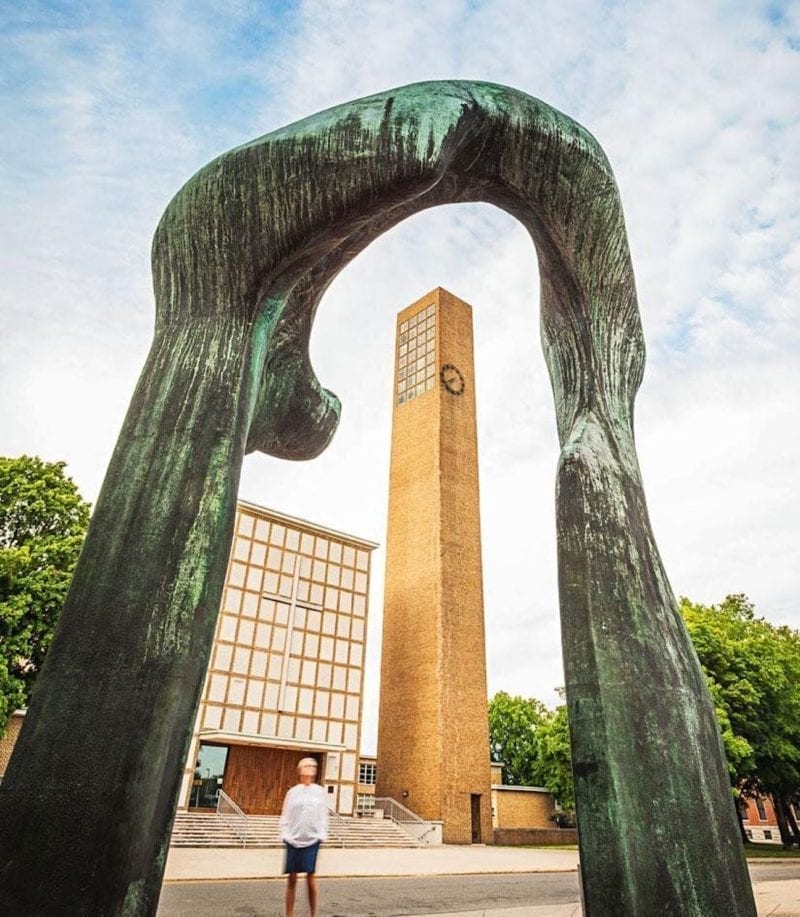“Travel Diaries: How to Explore From a Distance” is a Darling series focused on exploration and travel virtually from the comfort of your own home. 2020 and COVID-19 changed how we were able to travel, but they also taught us that a spirit of adventure and exploring never ceases.
Virtual travel allows us to explore places we may have once not noticed—the hills of central California, the countryside of New York, or for today, a small, Midwestern city in southern Indiana. A drive through Columbus, IN might seem like any other small town you’ve driven through with cute shops and restaurants. Take a closer look at the buildings and public spaces, and you will begin to notice something out of the ordinary.
With a population of roughly 45,000, Columbus possesses the greatest number of modernist architecture per capita than any other city in the United States. Columbus contains more than 60 buildings created by acclaimed architects and firms, including schools, businesses, churches and libraries. Hailed as the “Athens on the Prairie,” the American Institute of Architects (AIA) once ranked Columbus as America’s sixth best city for architectural innovation (among cities like Chicago, New York City and San Francisco).
Columbus illustrates that you don’t necessarily need to travel to big cities for extraordinary experiences; you might just discover wonder in unexpected places.
How It All Began
The architectural legacy of Columbus unfolded in the 1950s, primarily through the efforts of Columbus native and industrialist, J. Irwin Miller. The chairman of Cummins, a major Columbus-based diesel engine manufacturer, Miller believed passionately in architecture as a way to shape and influence civic life. In fact, his own family home was designed by Eero Saarinen, the designer of the Gateway Arch in St. Louis, MO.
In 1952, Miller along with his wife, Xenia Miller, established a philanthropic foundation and approached the city of Columbus with a fascinating new idea. For all new construction projects, his foundation would cover the architect’s fees and a percentage of the construction costs if the owners chose an architecture firm from a pre-selected list. What emerged was a mecca for modernist architecture in a small, southern Indiana town.
Discover the Treasures of Columbus
Check out this interactive map to get a picture of Columbus and the locations of some of its most celebrated architecture. There are more than 60 architecturally significant buildings spread throughout Columbus. I’ll highlight three of my favorite buildings here.
In the late 1960s, Myron Goldsmith designed a new office building and plant for the local newspaper, The Republic. The wide glass windows symbolized the transparency of journalism, allowing pedestrians to peer into the everyday operations of a newspaper.
Created by one of the few female architects in Columbus’s architectural legacy, First Financial Bank (formerly Irwin Union Bank) by Deborah Berke Partners, pushes back against the monotony of sprawling strip malls. A glowing light box appears to hover over the building, causing it to stand out from the sea of parking lots surrounding it.
Eliel Saarinen, father of Eero Saarinen, designed the First Christian Church, which is largely recognized as one of the first contemporary church buildings in America. With four interior divisions and a boxy exterior with a free-standing tower, the church reflects a return to the simplicity of the Christian religion.
Public Art
The public art of Columbus, scattered throughout the city for locals and visitors to interact with, complements its impressive architecture. A kinetic sculpture called Chaos I is perhaps the most iconic of these pieces. Designed by Swiss sculptor Jean Tinguely for The Commons, a community gathering place, the piece certainly lives up to its disorderly name.
The mechanical structure consists of levers and pulleys, a rotating mirror and a steel ball that constantly move and creak. The sculpture suits the modernist perspective of the city, while keeping with the lighthearted nature of the children’s play area a few feet away.
Watch a Film With Columbus as the Backdrop
In 2017, a movie filmed in Columbus premiered at the Sundance Film Festival to ecstatic reviews. With a backdrop of wide architectural shots, “Columbus” follows the stories of two strangers who form an unlikely bond amidst family hardships and navigating their own paths in life. Casey (Haley Lu Richardson), a lover of architecture, has lived in Columbus her whole life, and is struggling to decipher her next steps as she forgoes her first year of college to take care of her single mother.
Jin (John Cho) must also push pause on his life and begrudgingly stay in Columbus for an unknown period of time, when his father, a famed architecture scholar, falls ill during a tour stop in Columbus. The film paints a moving picture about the impact of connection and human relationship amongst the pain and cloudiness that life often brings. The film reflects the modernism of its surroundings with an unhurried pace and an unlikely romance.
Step Back Into Small Town History
Although its architectural legacy took off in the 1950s, Columbus itself was established in 1812, and the city still carries that classic charm. Columbus’s main downtown road, Washington Street, features boutiques, restaurants and a unique community center. Take a virtual tour of Zaharakos, a 1900s old-fashioned ice cream parlor with historic soda fountains and beautiful marble countertops. Try your own copycat recipe of the most famous dessert at Zaharakos, the lime-flavored Green River ice cream soda.
After indulging in ice cream, see the city of Columbus through historic eyes by browsing a collection of more than 70 postcards from Columbus’s early days. Dating back to the early 1900s, these postcards capture the allure of a small town before its explosion into an age of innovation and modernism.
With its extraordinary buildings and rich history, Columbus is not your ordinary small town. For a population of only 45,000, the city offers an expansive window into modernist architecture in America. As with cities like Columbus, virtual travel empowers us to look more closely at the places we would not normally visit and offers us a chance to grow in curiosity and wonder.
If you could travel anywhere in the world where would you go? How does traveling to new places make you feel?
Image via Midwest Living










